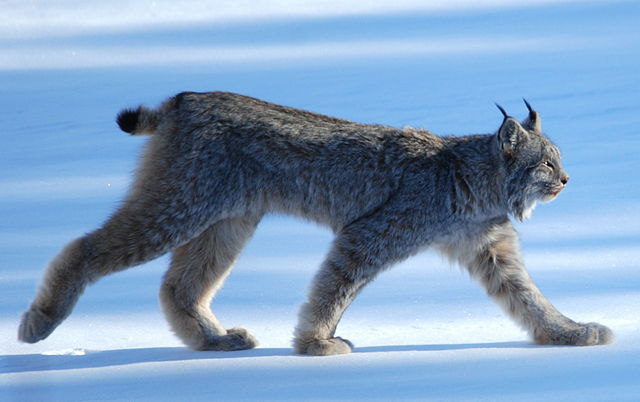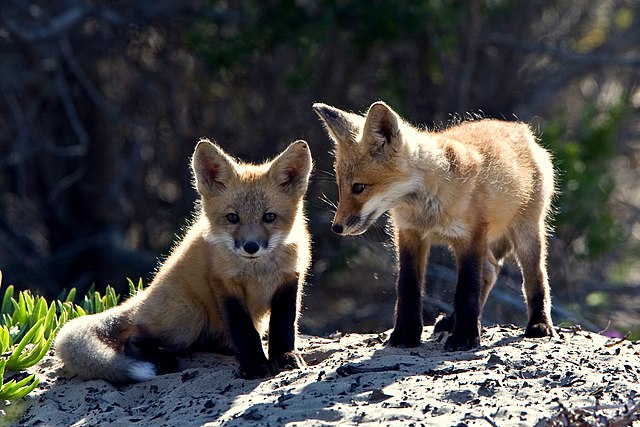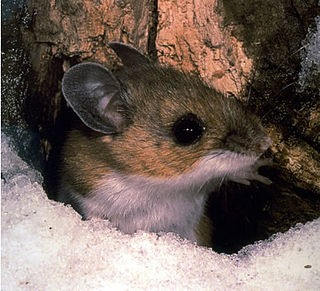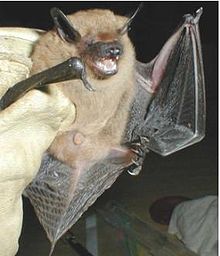Loading AI tools
From Wikipedia, the free encyclopedia
There are at least 14 large mammal and 50 small mammal species known to occur in Glacier National Park.

Species are listed by common name or scientific name.[1] Common and scientific names from R. S. Hoffman and D. L. Pattie, A Guide to Montana Mammals, 1968.[2]

Order: Carnivora, Family: Ursidae
Occurrence: Forests, slide areas, alpine meadows E W A
The American black bear (Ursus americanus) is North America’s smallest and most common species of bear. It is a generalist animal, being able to exploit numerous different habitats and foodstuffs. The American black bear is listed by the IUCN as least concern, due to the species’ widespread distribution and a large global population, estimated to be twice that of all other bear species combined.[3]
Order: Artiodactyla, Family: Bovidae
Occurrence: Open mountainous areas E W A
Bighorn sheep (Ovis canadensis)[4] is a species of sheep in North America[5] with large horns. The horns can weigh up to 30 pounds (14 kg), while the sheep themselves weigh up to 300 pounds (140 kg).[6] Recent genetic testing indicates that there are three distinct subspecies of Ovis canadensis, one of which is endangered: Ovis canadensis sierrae.
Order: Artiodactyla Family: Bovidae
Occurrence: Eastside parklands and prairies, E H
The American bison (Bison bison) is a North American species of bison, also commonly known as the American buffalo. These bison once roamed the grasslands of North America in massive herds; their range roughly formed a triangle between the Great Bear Lake in Canada's far northwest, south to the Mexican states of Durango and Nuevo León, and east along the western boundary of the Appalachian Mountains.[7]
Order: Carnivora, Family: Felidae
Occurrence: Open forests, brushy areas E W R
The bobcat (Lynx rufus) is a North American mammal of the cat family, Felidae. With twelve recognized subspecies, it ranges from southern Canada to northern Mexico, including most of the continental United States. The bobcat is an adaptable predator that inhabits wooded areas, as well as semi-desert, urban edge, forest edges and swampland environments. It persists in much of its original range and populations are healthy.

Order: Carnivora, Family: Felidae
Occurrence: Coniferous forests E W
The cougar (Puma concolor), also known as puma, mountain lion, mountain cat, catamount or panther, depending on the region, is a mammal of the family Felidae, native to the Americas. This large, solitary cat has the greatest range of any large wild terrestrial mammal in the Western Hemisphere, extending from Yukon in Canada to the southern Andes of South America. An adaptable, generalist species, the cougar is found in every major American habitat type. It is the second heaviest cat in the American continents after the jaguar. Although large, the cougar is most closely related to smaller felines.
Order: Carnivora, Family: Canidae
Occurrence: Forests, grasslands E W A
The coyote (/kaɪˈoʊtiː/ or /ˈkaɪ.oʊt/)[8] (Canis latrans), also known as the American jackal or the prairie wolf,[9] is a species of canid found throughout North and Central America, ranging from Panama in the south, north through Mexico, the United States and Canada. It occurs as far north as Alaska, but not the Canadian Arctic.[10]

Order: Artiodactyla, Family: Cervidae
Occurrence: Open forests, meadows E W A
The elk, or wapiti (Cervus canadensis), is one of the largest species of deer in the world and one of the largest mammals in North America and eastern Asia. In the deer family (Cervidae), only the moose, Alces alces (called an "elk" in Europe), is larger, and Cervus unicolor (the sambar deer) can rival the C. canadensis elk in size. Elk range in forest and forest-edge habitat, feeding on grasses, plants, leaves, and bark.

Order: Carnivora, Family: Ursidae
Occurrence: Forests, slide areas, alpine meadows E W A
The grizzly bear (Ursus arctos horribilis), also known as the silvertip bear, is a subspecies of brown bear (Ursus arctos) that generally lives in the uplands of western North America. Grizzlies are normally solitary active animals, but in coastal areas the grizzly congregates alongside streams, lakes, rivers, and ponds during the salmon spawn.

Order: Carnivora, Family: Felidae
Occurrence: Coniferous forests E W
The Canada lynx (Lynx canadensis) is a North American mammal of the cat family, Felidae. It is a close relative of the Eurasian lynx (Lynx lynx). Some authorities regard both as conspecific. However, in some characteristics, the Canada lynx is more like the bobcat (Lynx rufus) than the Eurasian lynx. With the recognized subspecies, it ranges across Canada and into Alaska as well as some portions of the northern United States.

Order: Artiodactyla, Family: Cervidae
Occurrence: Coniferous forests, lakes, slow streams, marshy areas E W
The moose (North America) or common European elk (Europe), Alces alces, is the largest extant species in the deer family. Moose are distinguished by the palmate antlers of the males; other members of the family have antlers with a "twig-like" configuration. Moose typically inhabit boreal and mixed deciduous forests of the Northern Hemisphere in temperate to subarctic climates.

Order: Artiodactyla, Family: Bovidae
Occurrence: High peaks and meadows E W A
The mountain goat (Oreamnos americanus), also known as the Rocky Mountain goat, is a large-hoofed mammal found only in North America. Despite its vernacular name, it is not a member of Capra, the genus of true goats. It resides at high elevations and is a sure-footed climber, often resting on rocky cliffs that predators cannot reach.
Order: Artiodactyla, Family: Cervidae
Occurrence: Open forests, meadows, often at high elevations E W A
The mule deer (Odocoileus hemionus) is a deer whose habitat is in the western half of North America. It gets its name from its large mule-like ears. Adult male mule deer are called bucks, adult females are called does, and young of both sexes are called fawns. The black-tailed deer is considered by some a distinct species though it is classified as a subspecies of the mule deer. Unlike its cousin, the white-tailed deer, mule deer are generally more associated with the land west of the Missouri River. The most noticeable differences between whitetails and mule deer are the color of their tails and configuration of their antlers. The mule deer's tail is black tipped.

Order: Carnivora, Family: Canidae
Occurrence: Coniferous forests E W
A gray wolf or grey wolf (Canis lupus), often known simply as the wolf which is the largest wild member of the family Canidae. It is an ice age survivor originating during the Late Pleistocene around 300,000 years ago.[11] DNA sequencing and genetic drift studies reaffirm that the gray wolf shares a common ancestry with the domestic dog (Canis lupus familiaris). Although certain aspects of this conclusion have been questioned, the main body of evidence confirms it. A number of other gray wolf subspecies have been identified, though the actual number of subspecies is still open to discussion. Northwestern wolves are typically apex predators in the ecosystems they occupy.
Order: Artiodactyla, Family: Antilocapridae
Occurrence: Eastside prairies, E H
The pronghorn (Antilocapra americana), is a species of artiodactyl mammal native to interior western and central North America. Though not a true antelope, it is often known colloquially in North America as the prong buck, pronghorn antelope or simply antelope,[12] as it closely resembles the true antelopes of the Old World and fills a similar ecological niche due to convergent evolution.[13] It is the only surviving member of the family Antilocapridae.[14]

Order: Carnivora, Family: Canidae
Occurrence: Grasslands, open forest E W R
The red fox (Vulpes vulpes) is a small canid native to much of North America and Eurasia, as well as northern Africa. It is the most recognizable species of fox and in many areas it is referred to simply as "the fox". As its name suggests, its fur is predominantly reddish-brown, but there is a naturally occurring grey morph known as the "silver" fox. The red fox is by far the most widespread and abundant species of fox, found in almost every single habitat in the Northern Hemisphere, from the coastal marshes of United States, to the alpine tundras of Tibetan Plateau.

Order: Carnivora, Family: Canidae
Occurrence: E, H
The swift fox (Vulpes velox) is a small light orange-tan fox around the size of a domestic cat found in the western grasslands of North America, such as Colorado, New Mexico and Texas.[15] It also lives in Manitoba, Saskatchewan and Alberta in Canada, where it was previously extirpated.[16] It is closely related to the kit fox and the two species are sometimes known as subspecies of Vulpes velox because hybrids of the two species occur naturally where their ranges overlap.
The swift fox lives primarily in short-grass prairies and deserts. Due to predator control programs in the 1930s, it was extinct in Canada for some time, but reintroduction programs have been successful in reintroducing the species. Due to stable populations elsewhere, the species is considered by the IUCN to be of least concern.[16]

Order: Artiodactyla, Family: Cervidae
Occurrence: Coniferous forests, meadows, creek and river bottoms, E W
The white-tailed deer (Odocoileus virginianus), also known as the Virginia deer, or simply as the whitetail, is a medium-sized deer native to the United States (all but five of the states), Canada, Mexico, Central America, and in South America as far south as Peru. The species is most common east of the Rocky Mountains, they are intermingled with a more robust species in the western United States (Odocoileus borealis) including Nevada, Utah, California, Hawaii, and Alaska (though its close relatives, the mule deer and black-tailed deer Odocoileus hemionus, can be found there). It does, however, survive in aspen parklands and deciduous river bottomlands within the central and northern Great Plains, and in mixed deciduous riparian corridors, river valley bottomlands, and lower foothills of the northern Rocky Mountain regions from Wyoming to southeastern British Columbia.
Order: Carnivora Family: Procyonidae

Order: Carnivora Family: Mustelidae
Order: Carnivora Family: Mephitidae

Order: Lagomorpha Family: Leporidae
Order: Lagomorpha Family: Ochotonidae

Order: Soricomorpha Family: Soricidae
Order: Rodentia Family: Castoridae

Order: Rodentia Family: Sciuridae
Order: Rodentia Family: Geomyidae

Order: Rodentia Family: Cricetidae
Order: Rodentia Family: Dipodidae

Order: Rodentia Family: Cricetidae
Order: Rodentia Family: Erethizontidae

Order: Chiroptera Family: Vespertilionidae
Seamless Wikipedia browsing. On steroids.
Every time you click a link to Wikipedia, Wiktionary or Wikiquote in your browser's search results, it will show the modern Wikiwand interface.
Wikiwand extension is a five stars, simple, with minimum permission required to keep your browsing private, safe and transparent.